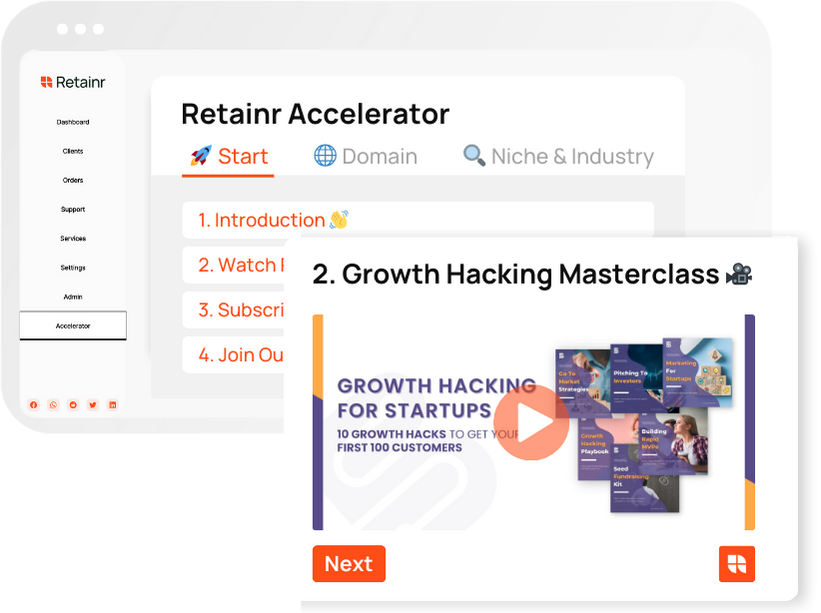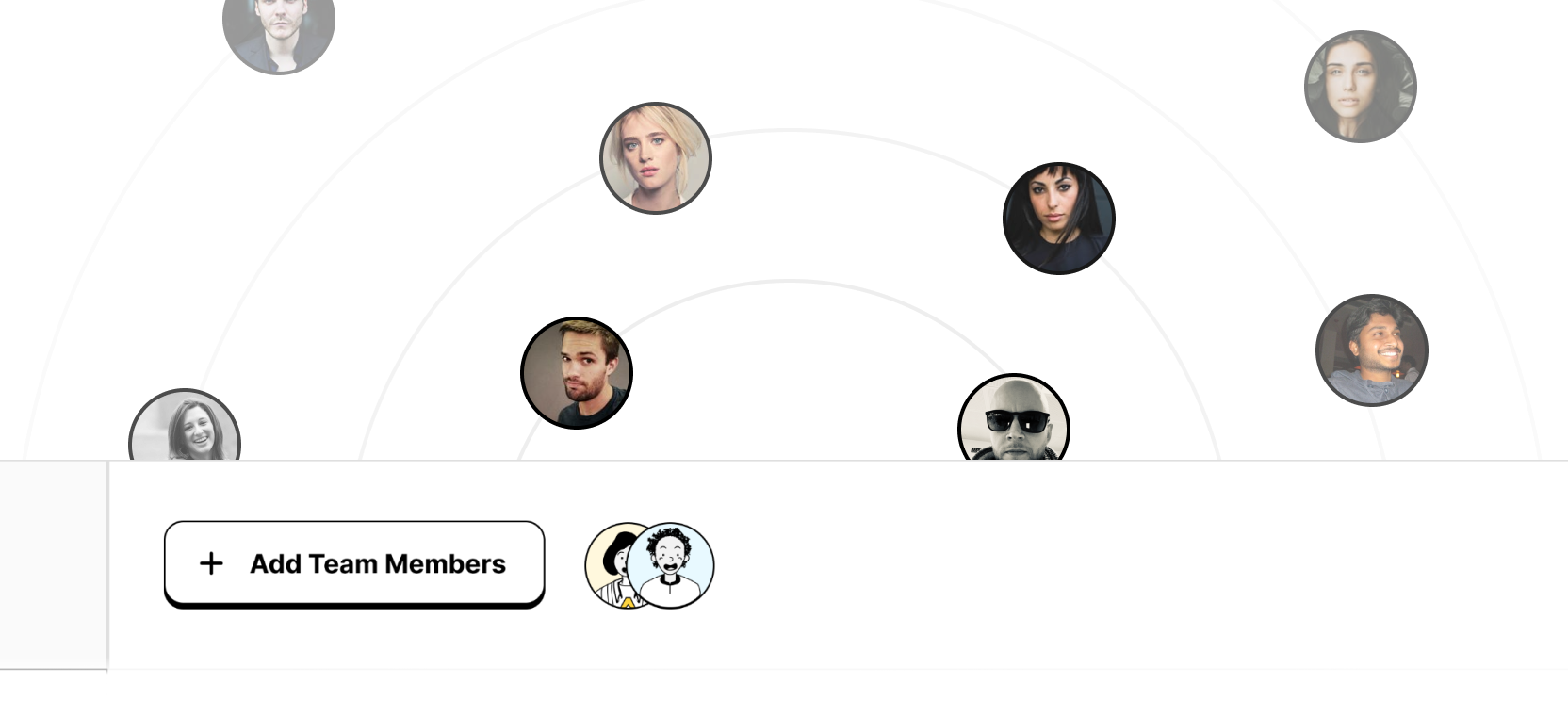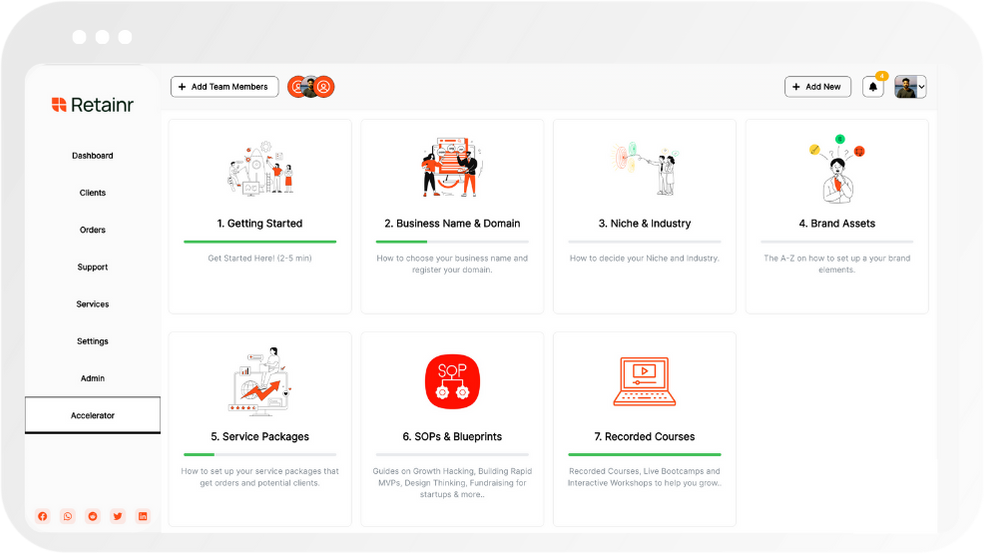
7 Step Client Onboarding Process with Templates
Build with Retainr
Sell your products and services, manage clients, orders, payments, automate your client onboarding and management with your own branded web application.
Get Started1. What is a 7 Step Client Onboarding Process with Templates?
Understanding the 7-Step Client Onboarding Process with Templates
The 7-Step Client Onboarding Process with Templates is a systematic approach towards integrating new clients into a company's operational infrastructure with ease. It outlines a series of actions required at each phase from establishing the initial contact with the client to fully integrating them into the company's system. The onboarding process, broken down into seven key steps and using templates, ensures that the client experiences a smooth and efficient transition, enhancing client retention and satisfaction.
Brief Overview of the 7-Step Process
This process involves the following sequential steps. The first step is Welcome and Account Setup - an introductory phase where the client is officially welcomed, and necessary groundwork like setting up an account is done. Following this, we have Data Collection - retrieving all essential information from the client for smooth operation. The third step is Product or Service Walkthrough, where the client is familiarized with the product/service they are subscribing to. Then it's time for Goals and Objectives Setting, outlining the expected outcomes and targeting to achieve them. The fifth step is Training, equipping the client with knowledge on how to use the product/service. Following this step is Follow Up and Reinforcement, which ensures the client is still on track and addresses any challenges experienced. Finally, the last step is Review and Feedback, where clients give their thoughts on the experience, and adjustments are made.
Role of Templates in the Process
The role of templates within this 7-step process cannot be overemphasized. They serve as guides, ensuring that each task is executed methodically and without omission. A typical example of how a step and template might be represented in a table format is shown below.
| Step | Description | Template Type |
|---|---|---|
| Welcome and Account Setup | Initial introductory phase and account creation | Welcome email and Account Setup Guidelines |
| Data Collection | Retrieval of essential client information | Data Collection Form |
2. Why is the 7 Step Client Onboarding Process important for businesses?
Significance of the 7 Step Client Onboarding Process
The 7 Step Client Onboarding Process is crucial for businesses for three key reasons: acquisition of insights, nurturing relationships, and fostering client loyalty.
- Acquisition of Insights: Onboarding helps to understand the clients' needs, expectations, and how best to deliver the services or products to meet these needs. The knowledge that is obtained during the onboarding process helps to tailor the offerings to the specific demands of the clients, thus enhancing their overall experience.
- Nurturing Relationships: Client onboarding gives businesses the opportunity to build a strong relationship with clients from the very onset. It can help to establish a solid foundation of trust, reliability, and transparency, which in turn can lead to better communication and more effective engagements in the future.
- Fostering Client Loyalty: A well-structured client onboarding process cements the client's decision to choose your business over others. It gives them the reassurance they need about their choice, thereby making them more likely to do business with your company in the future, thus fostering client loyalty and enhancing retention.
7 Step Client Onboarding Process
The 7 Step Client Onboarding Process and its crucial components can be summarized in the following table:
| Step | Description |
|---|---|
| 1. Welcome | Provide a warm welcome to make the client feel valued and important. |
| 2. Needs Assessment | Determine the client's needs, expectations, and goals. |
| 3. Statement of Work | Prepare and present a comprehensive action plan or roadmap. |
| 4. Documentation | Manage necessary paperwork and contractual formalities. |
| 5. Kick-off | Initiate the agreed plan with clear tasks and responsibilities. |
| 6. Regular Updates | Provide constant feedback and updates on the project's progress. |
| 7. Review and Feedback | Observe the outputs, ask for client feedback, and ensure client satisfaction. |
3. Can you explain each step of the 7 Step Client Onboarding Process?
Understanding the 7 Step Client Onboarding Process
The first step of the client onboarding process is 'Identification of Client Needs'. This involves doing some research to understand what your client needs and how your product or service can meet this need. During this stage, you should spend some time asking the client about their goals and objectives. This will help you tailor your approach to meeting these needs in future steps.
The second step is 'Mapping out a Client Journey'. This involves creating a detailed step-by-step plan of how you will meet the client's needs. This could involve a series of emails, phone calls, or meetings. It could also involve using a variety of different tools or software. During this stage, you also need to set clear deadlines and targets for each step of the way. The third step is 'Setting up the Client Account'. This can involve setting up a new client account in your system, inputting the client's details, and potentially creating a unique login for the client. This is a crucial step as it allows the client to access their account and track the progress.
| Step | Description |
|---|---|
| 4. 'Training and Demonstration' | In this step, use proper training methods or demonstrate the functioning of your product or service for clients to navigate easily. It may be done through webinars, instructional videos or detailed guides. |
| 5. 'Client Data Migration' | If applicable, ensure all client data from previous systems is accurately migrated to your system without any errors. This could be either physically transferring files over or entering data manually. |
| 6. 'Monitoring Client Engagement' | Keep a track of client interaction with your product or service. Utilize built-in analytics tools in your software or third-party tools to monitor their engagement and ensure they are utilizing the product effectively. |
| 7. 'Providing Ongoing Support' | The final step is to provide ongoing support to your client stands crucial in retaining them in the long run. This could involve regular check-ins, addressing any issues or concerns, and providing updates around improvements or new features in your product or service. |
4. What templates are available for the 7 Step Client Onboarding Process?
Customer Information Form Template
For the initial stage of the onboarding process, a well-structured customer information form can ensure you gather all important details. The template typically includes fields such as name, contact details, business type and specific needs or expectations. Here is a basic structure:
| Field | Information |
|---|---|
| Name | Client's full name |
| Contact Details | Email and phone number |
| Business Type | Client's industry or type of business |
| Expectations | Specific needs or expected outcome |
Product Walkthrough Guide Template
When introducing the client to your product or service, it is vital to have a comprehensive yet straightforward guide. This template helps to outline every feature and functionality. It is highly recommended to include screenshots or visuals. The structure covers:
- Introduction: Brief overview of the product.
- Features: Detailed description of functionalities.
- Instructions: Step-by-step user guide.
- Tips & Tricks: Enhancement notes and shortcuts, if any.
- Contact: Support details for further guidance.
Progress Report Template
Finally, maintaining an open stream of communication is essential for client retention. A progress report template can facilitate regular updates about milestones, achievements and potential areas of improvements. This can include:
- Objective: The agreed goal or objectives from the onset.
- Progress: The milestones achieved and their metrics.
- Review: Analysis of performance and comparison with desired outcomes.
- Next Steps: Recommendations for enhancements or next phase.
The templates can be easily adjusted to suit your company's needs and ensure smooth execution of the 7 step client onboarding process.
5. How can the templates enhance the 7 Step Client Onboarding Process?
Beneficial Role of Templates in a 7-Step Client Onboarding Process
Templates play a significant role in enhancing the efficiency of the 7 Step Client Onboarding Process. Primarily, they provide a clear structure to follow, ensuring that all necessary steps are taken and nothing is missed out. A predesigned template makes the process easier and manageable for customer success agents, effectively increasing productivity.
The key ways how templates can enhance the 7 Step Client Onboarding Process include:
- Standardization: Every client experiences the same, high-quality onboarding process.
- Consistency: Ensures the steps followed during the onboarding process are uniform across all clients.
- Time Efficiency: Saves time that would be spent writing emails or reminders from scratch.
- Minimize Errors: Pretested templates lower the chance of errors or oversights during the process.
Example of a Client Onboarding Process Template:
Below is an example of a simple template that outlines the steps in the Client Onboarding Process:
| Steps | Key Activities | Responsibility |
|---|---|---|
| Step 1: Customer Welcome | Send a welcome email, set an initial meeting | Customer Success Agent |
| Step 2: Needs Assessment | Identify client needs, challenges, and goal setting | Client Success Manager |
| Step 3: System Setup | Configure the system based on identified client needs | Technical Support Team |
| Step 4: Training | Training sessions on system usage | Training Team |
| Step 5: Monitor Progress | Track client's utilization and satisfaction | Customer Success Manager |
| Step 6: Review and Adapt | Assess progress, revisit goals, facilitate needed adjustments | Customer Success Agent |
| Step 7: Ongoing Support | Provide ongoing support and build a long-term relationship with the client | Technical Support Team |
6. How do I customize the templates for the 7 Step Client Onboarding Process according to my business needs?
Understanding the Customization Process
Customizing templates for the 7 Step Client Onboarding Process according to your business needs is a task that requires a clear understanding of your business model, clients, and services. Recognize that each business is unique and therefore the onboarding process may be different.
- You should start by reviewing each step of the process and determining what information is relevant to your business and clients.
- Next, review the forms and documents included in the provided templates. Adjust them based on the services you offer and the details you need from your clients.
- Finally, make sure to include your company branding, such as logos and company color schemes on all forms and templates to make them personalized and professional.
Practical Customization Steps
Now that we've outlined the initial steps let’s do a deep dive into practical steps when customizing your client onboarding templates:
| Step | Details |
|---|---|
| 1. Review and modify template content | This involves changing wording, adding, deleting, or rearranging sections based on relevance to your business. |
| 2. Add or delete forms | Some businesses might need additional forms that are not included in the original template. Add these to the template and be sure to remove any unnecessary ones to keep the process streamlined. |
| 3. Add company branding | Include your company logo, company name, and color scheme for brand continuity and professionalism. |
Considerations for Successful Customization
Customization is not solely about modifying the steps and forms but also about making the onboarding process simpler, seamless, and as efficient as possible. Here are some additional considerations:
- Ensure clarity – The process and requirements should be clear to avoid confusion for both your team and the clients.
- As much as possible, limit the process to necessary steps only. An overly complex process could turn off potential clients.
- Aim for a process that's not only efficient but also provides a positive experience for your customers. An effective onboarding process should make your clients feel welcomed, valued, and prepared for a successful business relationship.
7. Can you provide examples of how businesses have successfully used the 7 Step Client Onboarding Process with Templates?
Example 1: Software-as-a-Service Company
A prominent Software-as-a-Service (SaaS) company successfully made use of the 7 Step Client Onboarding Process. Here's how:
- Step 1: Customer data was collected via interactive forms during the signup process.
- Step 2: An onboarding template was used to send welcome emails, delivering immediate value by linking to useful resources and training.
- Step 3: A personalized checklist for setting up the software was sent, specifying tasks necessary for the client's successful setup.
- Step 4: Integrations with the client's existing software were incorporated into the setup process, with specialized templates to guide clients through the integration process.
- Step 5: The SaaS company delivered product training through webinars and linked to video tutorials via automated emails.
- Step 6: On-going communication ensured customer satisfaction and feedback while premium clients received emails from the customer success team for any needed assistance.
- Step 7: After successful onboarding, the clients were moved to their regular customer success manager who continued the relationship.
Example 2: E-commerce Business
An E-commerce business effectively utilized the 7 Step Client Onboarding Process in the following manner:
| Step | Action |
|---|---|
| 1 | Collected customer data at checkout and signup. |
| 2 | Sent a welcome email with an overview of services and benefits. |
| 3 | Provided personalized product recommendations based on user activity. |
| 4 | Offered easy navigation through the website with interactive tutorials. |
| 5 | Delivered value with exclusive discounts and benefits for new members. |
| 6 | Collected customer feedback through emails or onsite surveys. |
| 7 | Executed targeted marketing campaigns based on user preferences. |
Example 3: Subscription Box Service
A subscription box company implemented the 7 Step Client Onboarding Process as follows:
- Firstly, they gathered information from subscribers to customize the contents of the first box.
- A welcome letter was included in the first box explaining the benefits and what to expect from the subscription.
- Special instructions for making the most out of the subscription were provided alongside the products.
- Invitations for community engagement were sent through emails or via social media platforms to enhance the value of the subscription.
- Educational content including unboxing videos, blogs reviewing the products were shared for better understanding.
- Members were encouraged to provide feedback which in turn helped to personalize future boxes.
- Lastly, subscribers received regular communications about the upcoming products, renewing the excitement every month.
8. How does the 7 Step Client Onboarding Process with Templates help in improving customer relationship?
Enhancing Customer Relationships with 7 Step Client Onboarding Process with Templates
The 7 Step Client Onboarding Process with Templates paves the way for bolstering customer relationships. This methodical approach enables businesses to cater to clients' unique needs and ensures they feel valued. Moreover, with a structured onboarding process in place, businesses are more likely to retain and satisfy their customers by providing prompt, efficient service.
Key Benefits to Customer Relationship
- Increased engagement: An organized onboarding process engages clients from the onset, setting the tone for a fruitful, long-lasting relationship.
- Streamlined communication: With methodical steps in place, businesses can maintain regular yet non-intrusive contact with their clients, fostering strong communication lines.
- Customer retention: A smooth, efficient onboarding process can increase customer satisfaction, thus leading to higher retention rates.
- Up-selling opportunities: Once a solid foundation is built, businesses have a better chance to present additional services or products to their clients, creating avenues for up-selling or cross-selling.
Illustration Using a Sample Template
The efficacy of the 7 Step Client Onboarding Process with Templates can be illustrated using a sample table below. This represents a typical project management template, demonstrating how each step is geared towards fostering better customer relationships.
| Step | Task | Objective |
|---|---|---|
| 1 | Client discovery | To understand and cater to client's unique needs |
| 2 | Proposal | To provide the client with a detailed project plan and pricing |
| 3 | Agreement | To confirm client's approval and establish mutual expectations |
| 4 | Project kick-off | To introduce client to the team and discuss project specifics |
| 5 | Regular updates | To keep client informed about project progress |
| 6 | Feedback and revisions | To ensure client satisfaction by accommodating changes and improvements |
| 7 | Project wrap-up | To deliver the final project and seek client's approval |
Thus, the 7 Step Client Onboarding Process with Templates facilitates businesses in establishing, maintaining, and strengthening customer relationships through a well-defined, systematic approach.
9. Can the 7 Step Client Onboarding Process with Templates be automated?
Automation of the 7 Step Client Onboarding Process
The 7 Step Client Onboarding Process with Templates can indeed be automated to improve efficiency, consistency, reduce human error and free up more time for personnel to focus on other important areas of the business. Demand for automation is on the rise as many companies are realizing the benefits it brings along, particularly in the client onboarding realm.
Components of the Process That Can be Automated
- Needs Assessment: By using AI powered chatbots or online forms, clients can fill in necessary information about their needs and it can automatically be categorized and analysed.
- Proposal: Templates and client details can be used to automatically generate a proposal template for each client.
- Onboarding: Automated workflows can be created to guide clients through each step of the onboarding process.
- Training: Use of online learning platforms can deliver uniform, consistent training to all clients.
- Follow-Up: Email automation tools can be used to schedule and send follow-up emails on completion of certain onboarding steps.
Tools for Automating the Client Onboarding Process
| Steps | Automating Tools |
|---|---|
| Needs Assessment | AI chatbots, Online form builders |
| Proposal | CRM software, Document automation tools |
| Onboarding | Customer Onboarding software |
| Training | Online learning platforms |
| Follow-Up | Email automation tools |
Automating the client onboarding process does not only make the process smoother and faster, but it also enhances client experience. A positive onboarding experience can help build a strong, long-lasting relationship with a client, which eventually leads to higher client retention.
10. What are the common mistakes to avoid during the 7 Step Client Onboarding Process?
Common Mistakes to Avoid in Client Onboarding Process
In a seven-step client onboarding process, there are plenty of areas where errors can occur if not careful enough. The following is a non-exhaustive list of the most typical pitfalls:
- Lack of clear objectives: Not defining your goals clearly can lead to an ineffective onboarding process. Always remember what you need the client to achieve at every step of the onboarding.
- Insufficient communication: Regular touchpoints with the client are crucial to ensure they feel guided and supported throughout the onboarding process.
- Ignoring client feedback: Feedback is a valuable tool for improving your process. Ignoring it can result in an onboarding that fails to meet client's needs.
The mentioned mistakes can hinder a smooth client onboarding, which can negatively impact your relations with your customers. Therefore, it is necessary to avoid them at all costs.
Addressing These Mistakes in the 7 Step Onboarding Process
Here is how you can avoid each of the above-mentioned pitfalls in the context of each step of the client onboarding process:
| Onboarding Steps | How to Avoid Mistakes |
|---|---|
| Step 1: Welcome call or meeting | Set clear expectations and goals for the meeting. |
| Step 2: Data collection | Communicate around the data you are collecting, its purpose, and how it serves the client's interests. |
| Step 3: Internal Processing | Maintain timely updates to the client about the progress of their onboarding. Collect feedback about the process so far. |
| Step 4: Setup and customization | Explain the benefits of any custom settings to make the client understand their value. Consider feedback from the customers while making any customizations. |
| Step 5: Client training | Communicate effectively about the training material, check understanding, and adapt to the client’s learning speed and style. |
| Step 6: Follow up meeting | Use the follow-up meeting to discuss how the client feels about the onboarding process, any issues they faced, and how to improve the experience. |
| Step 7: Check-in and update | Continue to check in with the client regularly to keep them informed of any updates, taking into account their feedback to improve the relationship. |
Conclusion
Summary of 7 Step Client Onboarding Process with Templates
Successful customer onboarding is critical for boosting customer satisfaction, reducing churn, and increasing revenue. In the '7 Step Client Onboarding Process with Templates' blog, a step-by-step guide is provided to create an effective onboarding process. It starts with setting expectations, followed by preparing and sending a welcome pack. The third step involves holding a kick-off meeting, and the fourth one discusses creating an onboarding roadmap. Further, it talks about delivering training to clients, reviewing their onboarding experience and, finally, receiving feedback. Using templates and following these steps will streamline the onboarding process, improving clients' experiences and loyalty towards your brand.
Streamline Business Operations with Retainr.io
But, implementing such aspects could be overwhelming without a proper system. That's where Retainr.io comes in. Retainr.io is a whitelabel software that enables businesses to sell, manage clients, orders, and payments efficiently with their own branded app. It helps to adapt the '7 Step Client Onboarding Process' seamlessly in a digital format by facilitating communication, scheduling, monitoring, and tracking every step of the process in one place.
Retainr.io affords businesses control over their operations and provides insights that can lead to better decisions. Its user-friendly interface makes it easy for businesses to keep everything organized. Whether you're sending a welcome pack or receiving feedback, Retainr.io ensures every process is handled smoothly.
Improve your clients' onboarding experience, boost customer satisfaction, and grow your business with Retainr.io.
Boost Your Agency Growth
with Retainr Accelerator
Uncover secrets, strategies, and exclusive blueprints to take your agency's growth to the next level — from marketing insights to effective presentations and leveraging technology.

SOPs, Cheatsheets & Blueprints
Leverage 50+ SOPs (valued over $10K) offering practical guides, scripts, tools, hacks, templates, and cheat sheets to fast-track your startup's growth.
Connect with fellow entrepreneurs, share experiences, and get expert insights within our exclusive Facebook community.
.jpg)

Join a thriving community of growth hackers. Network, collaborate, and learn from like-minded entrepreneurs on a lifelong journey to success.

Gain expertise with recorded Courses, Live Bootcamps and interactive Workshops on topics like growth hacking, copywriting, no-code funnel building, performance marketing and more, taught by seasoned coaches & industry experts.

.jpg)

.jpeg)


